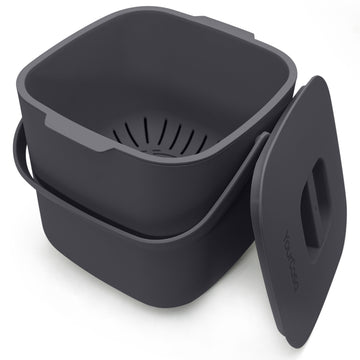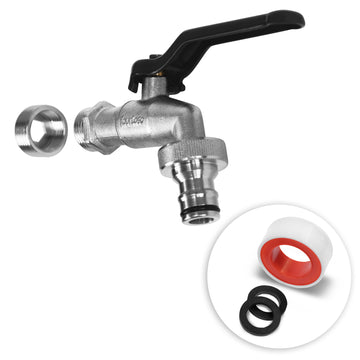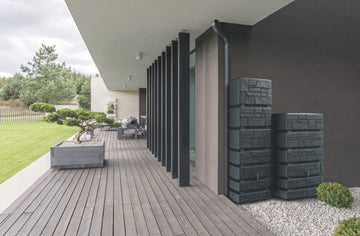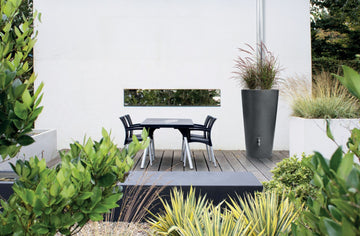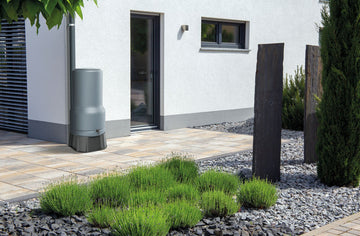
Saving water is right and important - today this is more true than ever before. Dry periods and the associated damage to the environment are becoming more and more common in Germany too. In your own garden, two things can help you to use the valuable resource of water more carefully: rain barrels and cisterns.
You are probably rightly asking yourself which of the two options is best for you and your garden – and in this article we will provide you with answers that will guide you in the right direction .
Rain barrel or cistern? The choice between a rain barrel and a cistern depends on your garden and water needs. A rain barrel is ideal for small gardens. It is inexpensive and easy to install. A cistern, on the other hand, is suitable for larger gardens and households with higher water consumption. It offers more storage capacity and can be installed underground, which saves space. Both systems save water and protect the environment. Choose the rain barrel for low needs and the cistern for larger projects.
What are the basic differences between a rain barrel and a cistern?
Rain barrels and cisterns differ significantly in their features and capacities. A typical rain barrel has a capacity of 100 to 500 liters and is usually made of plastic. It is installed above ground and collects rainwater from the roof of your house . The easy installation and low cost make it ideal for smaller gardens.
Cisterns, on the other hand, offer a much larger capacity, often between 1,000 and 10,000 liters or more. They are often made of robust materials such as concrete, plastic or steel and are installed underground, which saves space and protects the water from contamination. Such systems are ideal for larger gardens or households with high water demands and allow for more extensive use of the collected rainwater, for example for flushing the toilet or running the washing machine.
Rain barrels are much simpler to install and maintain than cisterns . They basically just collect water from your roof via the gutters and a downpipe. Rainwater cisterns, on the other hand, often have more complex systems with accessories such as pumps and filters to store and distribute the water efficiently.
| Characteristic | Rain barrel | cistern |
| capacity | 100–500 litres | 1,000-10,000+ liters |
| material | plastic | Concrete, plastic, steel |
| installation | Above ground | Underground |
| use | irrigation | Irrigation, toilets, washing machine |
| Cost | Small amount | Higher |
Ultimately, both systems have their advantages . The right choice depends largely on your specific needs and the size of your garden.
What are the advantages and disadvantages of rain barrels compared to cisterns?
Both systems have their advantages. There is no right or wrong , because the best choice for you depends on the intended use. If you have a small garden with little water requirements, a rain barrel can be completely sufficient. If, on the other hand, you want to collect a lot of rainwater and use it for household purposes, or if you live in a very rainy area, a larger investment in a cistern can be worthwhile.
Rain barrels are inexpensive and easy to install . Their simple construction made of plastic or wood makes them ideal for smaller gardens. You can easily connect them to a gutter and use the collected water directly. A big advantage is the low maintenance: occasional cleaning and checking is usually enough. However, the capacity of rain barrels is limited, which can be a disadvantage for larger gardens or high water requirements. In addition, they can be visible in the garden and may not look aesthetically pleasing - but YourCasa offers the ideal solution for this problem with aesthetic rain barrels .
Cisterns, on the other hand, have a much larger capacity and can be installed underground , which saves space and leaves the garden visually untouched. They are usually made of durable materials such as concrete or steel. Rainwater cisterns also allow for more versatile use of rainwater, for example for watering the garden with rainwater , flushing the toilet or washing the washing machine. However, the costs for purchase and installation are higher, and the installation is more complex - without professional help, not much can be done here. Maintenance is also more complex, as pumps and filters have to be checked regularly.
Here again are the advantages and disadvantages of rain barrels and cisterns at a glance:
- Rain barrel:
- Advantages: Cost-effective, easy to install, not much rain barrel accessories needed
- Disadvantages: Limited capacity, visible in the garden
- Cistern:
- Advantages: High capacity, underground, durable
- Disadvantages: Higher costs, complex installation, more complex maintenance

Who is a rain barrel suitable for and who is a cistern suitable for?
A rain barrel is ideal for smaller gardens, both in urban and rural areas. It is perfect for homeowners looking for a simple and inexpensive solution to collect rainwater for watering plants and flowers. In urban areas, where space is often limited, a rain barrel can be easily connected to a gutter and installed in a space-saving manner. A rain barrel can also be a practical and environmentally friendly solution in rural gardens that require less intensive watering.
A cistern is a better choice for larger properties with high water requirements . It is ideal for homeowners who want to not only water their gardens but also use rainwater for other purposes such as flushing the toilet or running the washing machine. Due to their larger capacity and the possibility of underground installation, cisterns are ideal for sprawling properties and intensive gardening projects.
Both systems can be easily integrated into different garden layouts . For example, a rain barrel can be placed next to a shed or greenhouse, where it is easily accessible and takes up little space - it also has a less significant impact on the aesthetics of the garden. It can also be integrated into the garden design in smaller urban gardens, for example behind a hedge or decorative cladding. Rainwater cisterns, on the other hand, can be installed invisibly under terraces, lawns or driveways, which makes them particularly suitable for large, open garden landscapes.
How does the local climate influence the decision between a rain barrel and a cistern?
The local climate, particularly the amount of rainfall and seasons , plays a decisive role in the choice between a rain barrel and a cistern. In regions with consistent, moderate rainfall, a rain barrel is often sufficient to meet the water demand. It fills up regularly as if by itself and offers an easy way to collect and use rainwater. The rain barrel is therefore an incredibly practical solution, especially in urban areas with limited space.
In areas with irregular or highly seasonal rainfall , such as Mediterranean climates , a cistern may be a better choice. These systems offer greater storage capacity, meaning they can also cope with longer dry periods. Cisterns are particularly advantageous in rural or suburban areas with sufficient space for underground installation and a high water demand.
So, try to adapt your choice to the specific climatic conditions . In rainy regions, the overflow system of the rain barrel should be well planned to avoid flooding. For rainwater cisterns in areas with extreme temperatures, appropriate insulation and a frost-proof design should be considered.
Regional examples illustrate the advantages of the respective systems:
| region | Local climate | Recommended system | Reason |
| Northern Germany | Regular rainfall | Rain barrel | Sufficient rainfall for smaller gardens |
| Southern France | Long dry periods | cistern | Large storage capacity for seasonal use |
| Alpine region | Heavy snowfall in winter | cistern | Underground storage protects against frost |
| Great Britain | Frequent rainfall | Rain barrel | Continuous rain supply for irrigation, similar to northern Germany |
| Southern Italy | Hot, dry summers | cistern | Storage of large quantities of water necessary |
| Black Forest | Heavy, consistent rainfall | Rain barrel | Regular rain is enough for garden irrigation |
| Northern Spain | Humid and mild climate | Rain barrel | Sufficient rainfall for regular use |
| Greece | Hot, dry summers | cistern | Large amounts of water for dry periods |
| Austria | Snow in winter, rain in summer | cistern | Protection against frost, large storage volumes |
| Belgium | Moderate, even rainfall | Rain barrel | Regular rain is enough for garden irrigation |
| Portugal | Mediterranean climate | cistern | Water storage for long dry periods |
| Netherlands | Frequent, consistent rainfall | Rain barrel | Continuous rain supply for irrigation |
| Poland | Cold winters, hot summers | cistern | Frost protection and high storage capacity |
| Switzerland | Heavy rain, snowfall | cistern | Frost protection and large storage volumes |
| Ireland | Frequent rainfall | Rain barrel | Regular rain is enough for garden irrigation |
So you see: The decision between a rain barrel and a cistern depends heavily on the local climate.

conclusion
Which system you should choose depends on your specific needs and local conditions . If you have a small garden, live in an urban environment and are looking for a cost-effective, easy-to-install solution, a rain barrel is ideal for you. It is perfect for watering plants and flowers and is easy to manage.
If, on the other hand, you have a large property, live in a region with irregular rainfall and want to use rainwater not only for the garden but also for household purposes, then a rainwater cistern is the better choice. It offers a high storage capacity and can be installed underground, which saves space and is more aesthetically pleasing.
For an informed decision and personal advice, please feel free to find out more or contact us directly. Take a look at YourCasa to discover great options and find the right system for your garden. Start using water sustainably today and discover how easy it can be to save water, reduce your water bill and protect the environment.

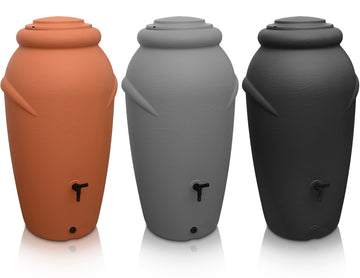
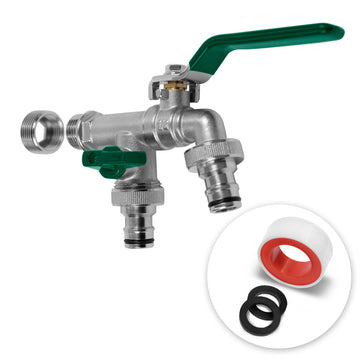
![Drei hohe YourCasa Regentonne 240 Liter [Wellen-Design] - Frostsicher & UV-beständige Gartentöpfe in den Farben Schwarz, Grau und Terrakotta, jeweils mit Drainagesystem für nachhaltige Bewässerung.](http://yourcasa.de/cdn/shop/files/ohnelogo_b8aeecac-557e-4106-a999-e77dcd160209.jpg?v=1707130230&width=360)
